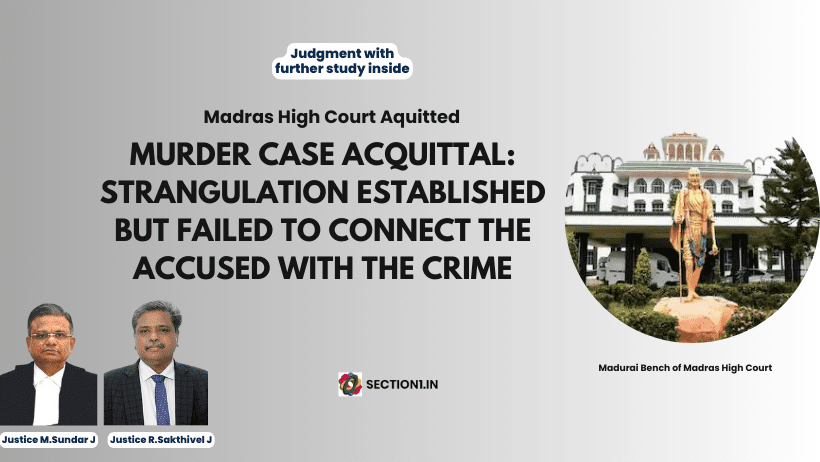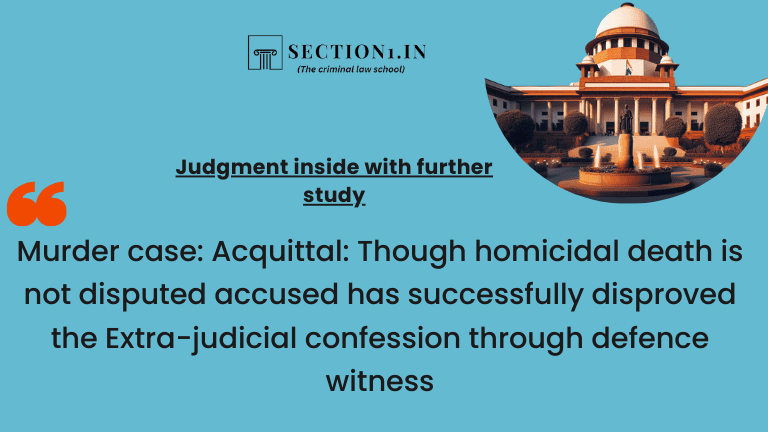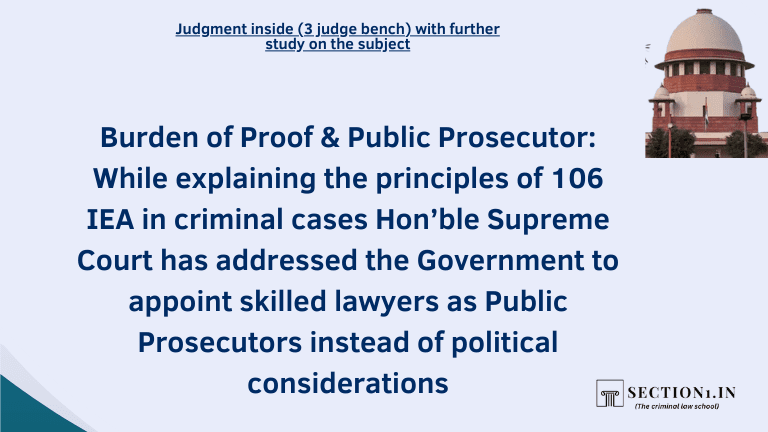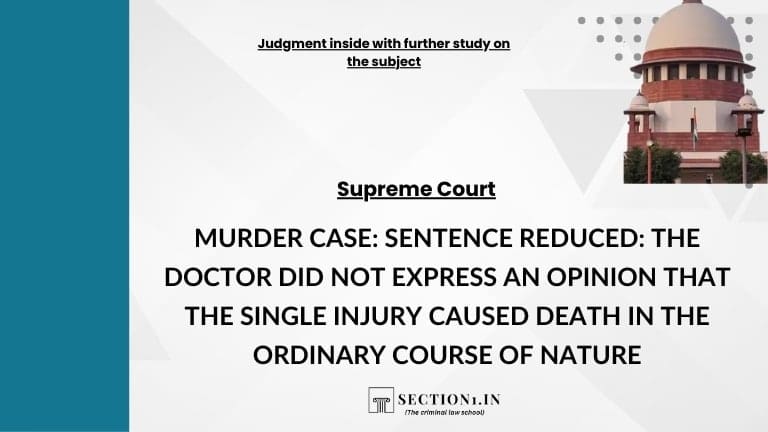This Criminal Appeal is preferred by the Appellants/Accused assailing the Judgment dated 29.09.2021 passed by the Fast Track Mahila Court, Ramanathapuram [for the sake of convenience and clarity, hereinafter referred to as ‘Trial Court’] in Sessions Case No.126 of 2018 in which the Appellants [for the sake of convenience and clarity, hereinafter ‘Appellants’ are called ‘Accused’ as described before and by the Trial Court] were convicted as follows:-
Accused No.1 Section 302 of IPC To undergo Rigorous Imprisonment for Life and a fine of Rs.1000/-, in default of payment of fine, further undergo Simple Imprisonment for 1 year. Section 201 of IPC To undergo Rigorous Imprisonment for 2 years and a fine of Rs.1000/-, in default of payment of fine, further undergo Simple Imprisonment for 6 months.
Accused No.2 Section 201 of IPC To undergo Rigorous Imprisonment for 2 years and a fine of Rs.1000/-, in default of payment of fine, further undergo Simple Imprisonment for 6 months.
Accused No.3 Section 201 of IPC To undergo Rigorous Imprisonment for 2 years and a fine of Rs.1000/-, in default of payment of fine, further undergo Simple Imprisonment for 6 months.
Note:- The substantial period of sentences was ordered to run concurrently. The period of imprisonment, if any already undergone, was ordered to be set off under Section 428 of Cr.P.C.
Facts of the case
Accused no.1 Suspecting fidelity of the wife – First Attempt
2.1. Accused No.2 is the son of Accused No.1 and Accused No.3 is the brother-in-law of Accused No.2. Accused No.2 was born through the first wife of Accused No.1. The first wife of Accused No.1 passed away 15 years ago. Then, Accused No.1 married one Kanaga as his second wife. She lived estranged from her husband and their two children. Out of the marriage between Accused No.1 and Kanaga, a female child was born. Accused No.1 had Brick Kiln Unit on his land and lived with Kanaga in the Brick Kiln Unit. Later, Accused No.1 suspected her fidelity, due to which, a frequent quarrel arose between them. Hence, Accused No.1 decided to kill her.
2.2. On 24.07.2017, at about 11 a.m., when Kanaga was lying down in the hut, Accused No.1 with an intention to kill her entered the hut and caused injury on her head, back and rib by using wooden log. Kanaga went unconscious. Immediately, Accused No.1 called Accused No.2 and asked him to admit her to the Government Hospital. Accused Nos.2 & 3 brought Kanaga in the Car of Accused No.3 and admitted her to the Government Hospital, Ramanathapuram for treatment by stating that she fell down from a motorcycle.
Second attempt – Accused no.1 killed his wife
2.3. The next day, i.e. on 25.07.2017, Accused No.1 with an intention to kill Kanaga asked Accused No.2 to discharge the Kanaga from the Hospital. Accused Nos.2 and 3 went to the Hospital, discharged Kanaga against the medical advice and dropped her in the Omni Van of Accused No.3 in the Brick Kiln Unit at 01.00 p.m. Thereafter, Accused No.1 with an intention to kill Kanaga strangulated her neck by using his hands and her sacred thread and thereby killed her. Thereafter, Accused No.1 called Accused Nos.2 & 3 and informed them about the occurrence. Accused Nos.2 & 3 came to the scene of occurrence and hid the wooden log. Accused No.1 hid the blood stained pillow, bedsheet and sacred thread in a pit. They hastily brought the dead body of Kanaga (deceased) to a graveyard and tried to burn it.
xxx
Appeal
5. Aggrieved with the above conviction and sentence, Accused Nos. 1 to 3 preferred this appeal under Section 374(2) of Cr.P.C. This Court has perused the case file and grounds of appeal. After hearing both sides arguments, following points arose for consideration:-
1. Whether the prosecution has proved charges levelled against the Accused No.1 under Section 302 & 201 of IPC beyond reasonable doubt?
2. Whether the prosecution has proved charges levelled against Accused Nos.2 & 3 under Section 201 of IPC beyond reasonable doubt?
3. Is there any reason to interfere with the Trial Court Judgment?
Judgment relied on the side of the appellant
i. Jose’s case [Jose alias Pappachan Vs. Sub-Inspector of Police, Koyilandy and another, reported in (2016) 10 SCC 519];
ii. Satish Nirankari’s case [Satish Nirankari Vs. State of Rajasthan, reported in (2017) 8 SCC 497];
iii. Indrajit Das’s case [Indrajit Das Vs. The State of Tribura, reported in 2023 LiveLaw (SC) 152];
iv. Dharmendra Nishad’s case [Dharmendra Nishad Vs. State of U.P., Neutral Citation No. 2021:AHC:101426- DB].
Judgments relied by the state
i. Ponnusamy’s case [Ponnusamy Vs. State of Tamil Nadu reported in (2008) 5 SCC 587 : (2008) 2 SCC (Cri) 656];
ii. Ravirala Laxmaiah’s case [Ravirala laxmaiah Vs. State of Andhra Pradesh reported in (2013) 9 SCC 283];
iii. Prem Singh’s case [Prem Singh Vs. State (NCT of Delhi) reported in (2023) 3 SCC 372].
Discussion to Point Nos.1 & 2
8. Before going into the merits of the case, it is apposite to state the legal position in respect of a case rested only upon circumstantial evidence.
Hon’ble Madras High Court for circumstantial evidence has placed reliance on the following Hon’ble Supreme Court judgments:
i. Hanumant Vs. State of Madhya Pradesh, reported in (1952) 2 SCC 71 – para.11];
ii. Sharad Birdhichand Sarda’s case [Sharad Birdhichand Sarda Vs. State of Maharashtra reported in (1984) 4 SCC 116 : 1984 SCC (Cri) 487 – para.153]
Thereafter Madras High Court division bench has held…
8.2. In Ashok Kumar Srivastava’s case [State of Uttar Pradesh Vs. Ashok Kumar Srivastava reported in (1992) 2 SCC 86], the Hon’ble Supreme Court has pointed out that great care must be taken while evaluating circumstantial evidence and if the evidence relied on is reasonably capable of two inferences, the one in favour of the accused must be adopted. Further, the circumstances relied upon must be found to have been fully established and the cumulative effect of all the facts so established must be consistent only with the hypothesis of guilt.
Position regarding Extra-judicial confession
8.3. As far as the extra-judicial confession is concerned, it is admissible under Section 24 of the Evidence Act, provided, if it is free from any inducement, threat or promise. It is a rule of caution that the Court would generally look for independent reliable corroboration before placing reliance upon an extra-judicial confession. But when such extra-judicial confession is corroborated with several other proved circumstances, the Court can rely upon such extra-judicial confession vide Balwinder Singh’s case [Balwinder Singh Vs. State reported in 1995 SUPP (4) SCC 259].
Position regarding confession of accused
8.4. As far as the confession given by the Accused No.1 is concerned, if a confession is made after arrest and if it leads to discovery of new facts or recovery of any article, the same alone is admissible under Section 27 of the Evidence Act [vide Pulukuri Kottaya Vs. King Emperor reported in AIR 1947 PC 67].
Approach of Division Bench
9. In the light of the above legal principles, this Court approaches this case. The following circumstances have been projected by the prosecution to connect the Accused to the offence for which they were convicted:-
i. On 24.07.2017, Accused No.1 attacked the deceased by using wooden log and caused injury on head, back and rib of the deceased and called Accused Nos.2 & 3 and asked them to admit the deceased in the Government Hospital, Ramanathapuram.
ii. On 25.07.2017, Accused Nos.2 & 3 went to the Government Hospital, Ramanathapuram and discharged the deceased against medical advice.
iii. On 25.07.2017, Accused Nos.2 & 3 dropped the deceased in the alleged place of occurrence, i.e. Brick Kiln Unit.
iv. Accused No.1 with an intention to kill the deceased strangulated her neck by using her sacred thread and his hands and killed her.
v. Arrest and confession of Accused No.1
vi. Accused No.1 hid the blood stained pillow, bedsheet and sacred thread in a pit in his Brick Kiln Unit.
vii. Accused No.2 hid the wooden log said to have been used for committing murder in the Brick Kiln Unit premises.
viii. All the Accused persons brought the dead body of the deceased to the graveyard and tried to burn the dead body hastily.
ix. The evidence of post-mortem report and deposition of post-mortem doctor that the deceased died due to strangulation.
x. The alleged extra judicial confession xi. Recovery of M.O.1 to M.O.5.
xii. Motive
10.1. From the medical evidence, it can be seen that the deceased had injury on her head and her rib.
Prosecution did not prove the discharge of deceased against the advice of the doctors by accused no.2 & 3 and other circumstances
10.4. It is alleged that the signature found in the document is that of Accused No.2. But, the prosecution did not prove the said writings as per law. Hence, this Court is of the considered view that the prosecution case that Accused Nos.2 & 3 admitted Kanaga (deceased) in the Hospital on 24.07.2017 and discharged on 25.07.2017 against medical advice is doubtful and is not proved by the prosecution.
10.5. According to the prosecution case, Accused Nos.2 & 3 dropped Kanaga (deceased) after discharge from the Hospital in the Brick Kiln Unit. In this regard, there is no evidence available on record. The prosecution has failed to establish the above said circumstances.
Intact of hyoid bone
Defence version: 11.2. The learned counsel appearing for Accused submitted that in this case, hyoid bone was intact and therefore, death of Kanaga (deceased) may be due to suicide and not due to alleged strangulation. In this regard, he relied on the decision of the Hon’ble Supeme Court in Satish Nirankari’s case referred to supra. The fact of the said case is that one Pooja was murdered by Accused therein who had strangulated her neck by way of squeezing. In the said facts and circumstances, the Hon’ble Supreme Court after referring to Modi’s Medical Jurisprudence and Toxicology held as follows:-
38. … If the death would have been strangulation then fracture of larynx and trachea and hyoid bone was a must, there should have been scratches, abrasions and finger nail marks and bruises on the face, neck and other parts of the body. …
Prosecution version: According to the learned Additional Public Prosecutor, hyoid bone may, in rare cases, be fractured. Prosecutor relied on Ravirala Laxmaiah’s (supra para. 16).
Circumstance favours the accused and there is no evidence to connect the accused and crime
11.4. In this case, P.W.14 Post-Mortem Doctor has deposed that the deceased died due to the strangulation. But, there is no evidence to say that Accused No.1 and deceased were last seen together. According to the prosecution evidence, Accused persons brought the dead body to the graveyard and tried to burn it at 2.40 p.m. In the Medical Reports, it has been noted that the deceased was discharged against the medical advice at 2.00 p.m. Hence, as already stated supra, there is no evidence to state that Accused Nos.2 & 3 dropped Kanaga (deceased) in the Brick Kiln Unit. Further, at the same time, there is no reason to reject the evidence of P.W. 14 Post-Mortem Doctor. Hence, the prosecution has proved that the deceased died due the strangulation by neck. But the prosecution miserably failed to establish that Accused No.1 has committed the offence. There is no evidence available on record to connect the crime with the Accused.
Recovery doubtful
12.1. As far as recovery of Material Objects is concerned, P.W.1 has deposed that on 25.07.2017 itself, police came to the graveyard, seized dead body of the deceased and brought Accused to police station. The learned Additional Public Prosecutor has submitted that the police called Accused Nos.1 & 2 only for an enquiry and the police did not arrest them on that day. It is alleged that Accused No.1 voluntarily gave a confession to the Investigating Officer (P.W.17). The admissible portion of the confession was marked as Ex.P23. Based on the confession, M.O.1 to M.O.4 were said to have been seized by the P.W.17. It has been stated that the Investigating Officer (P.W.17) found that blood has been stained in M.O.1 & M.O.2 and therefore, M.O.1 & M.O.2 were sent to Forensic Science Laboratory (FSL). FSL Report was marked as Ex.P20. In the said Report, it has been stated that blood stains in M.O.1 & M.O.2 relates to ‘B’ Group. But, the prosecution did not collect the sample blood from the deceased. No reason was assigned by the prosecution in this regard. Hence, the recovery of M.O.1 to M.O.4 by the Investigating Officer (P.W. 17) based on the confession of Accused No.1 has not been established by the prosecution. If the prosecution has established that the blood stains in M.O.1 and M.O.2 is that of the deceased, then only the Court can draw inference that the Accused No.1 has voluntarily given confession. Otherwise, it cannot be construed that the blood stains in M.O1 & M.O.2. is that of the deceased. The prosecution thus failed to prove the same and therefore, the recovery of material objects (MO1 to MO4) is doubtful.
14. Hence, this Court comes to the conclusion that the prosecution has not proved charges levelled against Accused. Therefore, Point No.1 & 2 are answered in favour of the Accused and against the prosecution.
How to appreciate Section 106 Evidence Act?
15.1. The Trial Court has relied on Section 106 of Evidence Act and came to the conclusion that the burden of proof shifted to the Accused. This Court is of the view that only if the prosecution establishes the case, onus of proof can be shifted to Accused. The prosecution failed to prove that the Accused persons committed murder and establish the prosecution case. Onus does not shift to the Accused. Hence, this Court is of the view that the Trial Court findings ought to be interfered with by this Court and accordingly it is interfered with. The Point No.3 is answered accordingly in favour of the Accused and against the prosecution.
Compensation portion of the trial court sustained
16. Before writing operative portion of the Judgment, this Court wants to state that the Trial Court concluded that the deceased’s daughter namely, Pradeepa is entitled to receive compensation from the Government for education expenses, food and future prospects and requested the District Legal Service Authority to fix the compensation to be paid to the deceased’s daughter Pradeepa. Though the impugned Judgement dated 29.09.2021 passed by the learned Fast Track Mahila Judge, Ramanathapuram in S.C.No.126 of 2018 is to be interfered with by this Judgment, the findings of the Trial Court in respect of payment of compensation to the deceased daughter Pradeepa is liable to be sustained and is accordingly sustained. District Legal Service Authority, Ramanathapuram is directed to act in this regard as per the directions of the Trial Court without influence of the result of the appeal.
Accused Acquitted.
1.Shanmugam, S/o.Velu 2.Praveenkumar, S/o.Shanmugam 3.Murugan, S/o.Ganesan … Appellants Vs. State rep. by its, The Inspector of Police, Kenikarai Police Station, Ramanathapuram District. (Crime No.530/2017) … Respondent – Crl.A.(MD) No.448 of 2021 – Pronounced on 08.11.2023 CORAM THE HONOURABLE MR.JUSTICE M.SUNDAR and THE HONOURABLE MR.JUSTICE R.SAKTHIVEL – Division bench – Madurai Bench of Madras High Court
https://www.mhc.tn.gov.in/judis/index.php/casestatus/viewpdf/912148
Further study on the subject
PROSECUTION NOT PROVED THE MURDER CASE BEYOND REASONABLE DOUBT. – Section1
LAST SEEN THEORY – IPC – EXPLAINED. – Section1
APPRECIATION OF EVIDENCE – CIRCUMSTANTIAL EVIDENCE & RECOVERY U/S 27 IEA. – Section1
ALL PRINCIPLES ON APPRECIATION OF EVIDENCE DISCUSSED _ S.C – Section1
LAST SEEN TOGETHER, EXTRA-JUDICIAL CONFESSION & CIRCUMSTANTIAL EVIDENCE – Section1
EVIDENTIARY VALUE OF EXTRAJUDICIAL CONFESSION – EXPLAINED – Section1
ACQUITTAL BY USING ENTIRE PROCEDURES AVAILABLE TO DISPROVE THE PROSECUTION CASE – Section1






